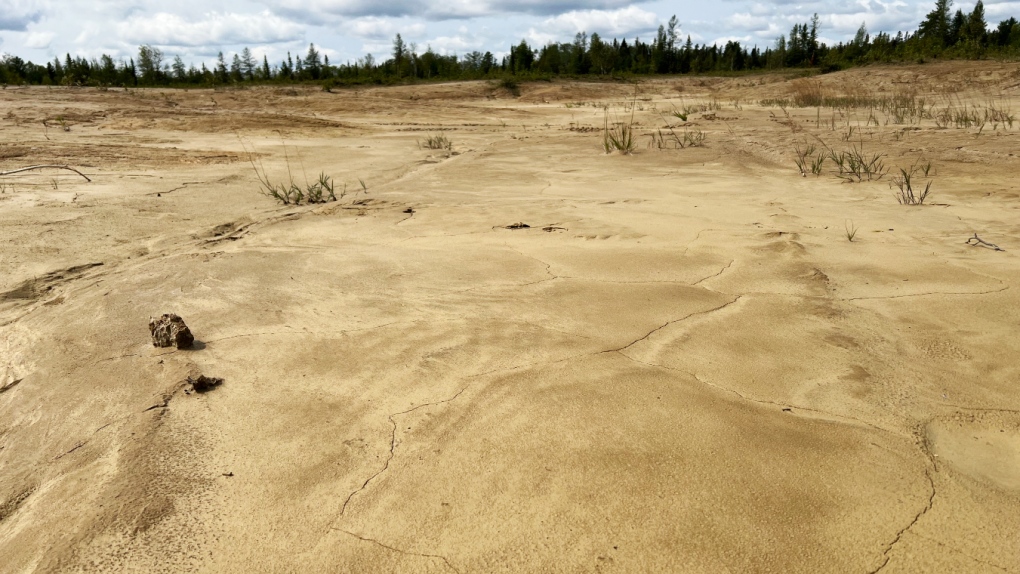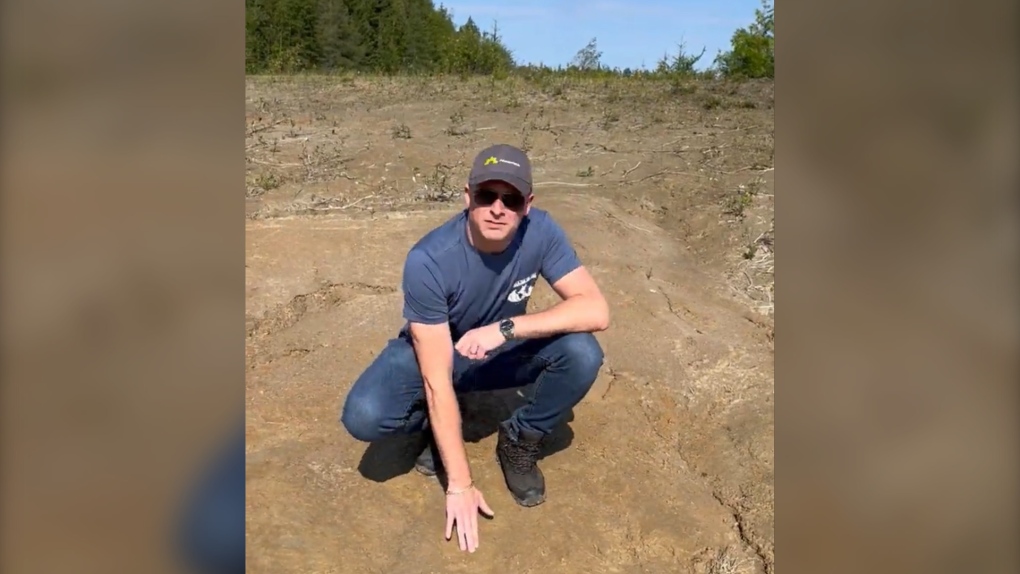Company works on plan to extract gold from mine tailings near Kirkland Lake, Ont.
 The Teck-Hughes mine, which produced from 1917 to 1968, has an estimated 138,460 in its tailings. (Photo courtesy of Fulcrum Metals)
The Teck-Hughes mine, which produced from 1917 to 1968, has an estimated 138,460 in its tailings. (Photo courtesy of Fulcrum Metals)
Two former mine sites near Kirkland Lake, Ont., could soon be producing gold again – and the sites could be cleaned up in the process.
U.K.-based Fulcrum Metals is hoping to extract gold from tailings piles leftover from two former gold mines: the Teck-Hughes mine, which produced from 1917 to 1968, and the Sylvanite mine, which produced from 1927-1961.
Using Extrakt's non-toxic technology would allow Fulcrum to extract gold without the use of cyanide.
"Our recent site visits to Teck-Hughes and Sylvanite allowed us to examine the significant tailing bodies at both sites, which run for kilometres and contain considerable quantities of gold," Fulcrum CEO Ryan Mee said in a news release earlier this month.
Initial testing has shown that using technology from Extrakt would allow a gold recovery rate from the tailings of 59.4 per cent, compared with 30 per cent using cyanide leaching.
"We are, therefore, continuing discussions with Extrakt about the application of its technology and look forward to finalizing terms for exclusive licensing of Extrakt's gold tailings technology in Timmins and Kirkland (Lake), in due course," Mee said.
Out of 6,531,300 tonnes of tailings at the Teck-Hughes tailings site, located 2.6 kilometres from Kirkland Lake, there is an estimated 138,460 ounces of gold.
 At the Sylvanite tailings site, five kilometres from Kirkland Lake, 4.14 million tonnes of tailings contain an estimated 67,051 ounces of gold. (Photo courtesy of Fulcrum Metals)
At the Sylvanite tailings site, five kilometres from Kirkland Lake, 4.14 million tonnes of tailings contain an estimated 67,051 ounces of gold. (Photo courtesy of Fulcrum Metals)
At the Sylvanite tailings site, five kilometres from Kirkland Lake, 4.14 million tonnes of tailings contain an estimated 67,051 ounces of gold.
- Download our app to get local alerts on your device
- Get the latest local updates right to your inbox
Both estimates are based on historic and recent data and still have to be verified, Fulcrum said, and more recent samples are being tested and analyzed to firm up the estimates.
"A primary focus is on determining the amount of gold in the projects through various development work streams so that investors and the market can appreciate better the scale and in-situ value of our first projects," Mee said.
"An important outcome from reprocessing tailings is the removal of heavy metals and the cleaning up and reclamation of the tailings areas to provide positive opportunities for land to be repurposed."
Mee and other officials met with representatives from Matachewan First Nation and Beaverhouse First Nation during a August site visit to consult them on their plans.
"I am hugely grateful for the welcome we received during consultation and engagement meetings with local stakeholders prior and during our recent visit," Mee said.
 Fulcrum Metals CEO Ryan Mee visited the Kirkland Lake sites in August, and also met with respresentatives from Matachewan First Nation and Beaverhouse First Nation. (Photo courtesy of Fulcrum Metals)
Fulcrum Metals CEO Ryan Mee visited the Kirkland Lake sites in August, and also met with respresentatives from Matachewan First Nation and Beaverhouse First Nation. (Photo courtesy of Fulcrum Metals)
"It was a pleasure to meet the chiefs and people from the First Nation groups and I would like to thank everyone for their hospitality, interest and positivity towards what Fulcrum is seeking to achieve."
Fulcrum said it discussed its plans for the Teck-Hughes and Sylvanite tailing sites, "which will involve removing heavy metals and cleaning up and reclaiming the tailings areas to provide positive opportunities for land to be repurposed."
In addition to core samples, the company is considering deploying drones with ground-penetrating radar to help survey the site and getting permits to take bulk samples to get a better idea of how much gold could be extracted.
"Our focus has been on how we bring these legacy assets into the modern world of sustainable extraction though our work with Extrakt and its non-toxic technology," Mee said.
Read the full news release at Fulcrum's website.
CTVNews.ca Top Stories

opinion Tom Mulcair: Prime Minister Justin Trudeau's train wreck of a final act
In his latest column for CTVNews.ca, former NDP leader and political analyst Tom Mulcair puts a spotlight on the 'spectacular failure' of Prime Minister Justin Trudeau's final act on the political stage.
B.C. mayor gets calls from across Canada about 'crazy' plan to recruit doctors
A British Columbia community's "out-of-the-box" plan to ease its family doctor shortage by hiring physicians as city employees is sparking interest from across Canada, says Colwood Mayor Doug Kobayashi.
'There’s no support': Domestic abuse survivor shares difficulties leaving her relationship
An Edmonton woman who tried to flee an abusive relationship ended up back where she started in part due to a lack of shelter space.
opinion King Charles' Christmas: Who's in and who's out this year?
Christmas 2024 is set to be a Christmas like no other for the Royal Family, says royal commentator Afua Hagan. King Charles III has initiated the most important and significant transformation of royal Christmas celebrations in decades.
Baseball Hall of Famer Rickey Henderson dead at 65, reports say
Rickey Henderson, a Baseball Hall of Famer and Major League Baseball’s all-time stolen bases leader, is dead at 65, according to multiple reports.
Arizona third-grader saves choking friend
An Arizona third-grader is being recognized by his local fire department after saving a friend from choking.
Germans mourn the 5 killed and 200 injured in the apparent attack on a Christmas market
Germans on Saturday mourned the victims of an apparent attack in which authorities say a doctor drove into a busy outdoor Christmas market, killing five people, injuring 200 others and shaking the public’s sense of security at what would otherwise be a time of joy.
Blake Lively accuses 'It Ends With Us' director Justin Baldoni of harassment and smear campaign
Blake Lively has accused her 'It Ends With Us' director and co-star Justin Baldoni of sexual harassment on the set of the movie and a subsequent effort to “destroy' her reputation in a legal complaint.
Oysters distributed in B.C., Alberta, Ontario recalled for norovirus contamination
The Canadian Food Inspection Agency has issued a recall due to possible norovirus contamination of certain oysters distributed in British Columbia, Alberta and Ontario.

































